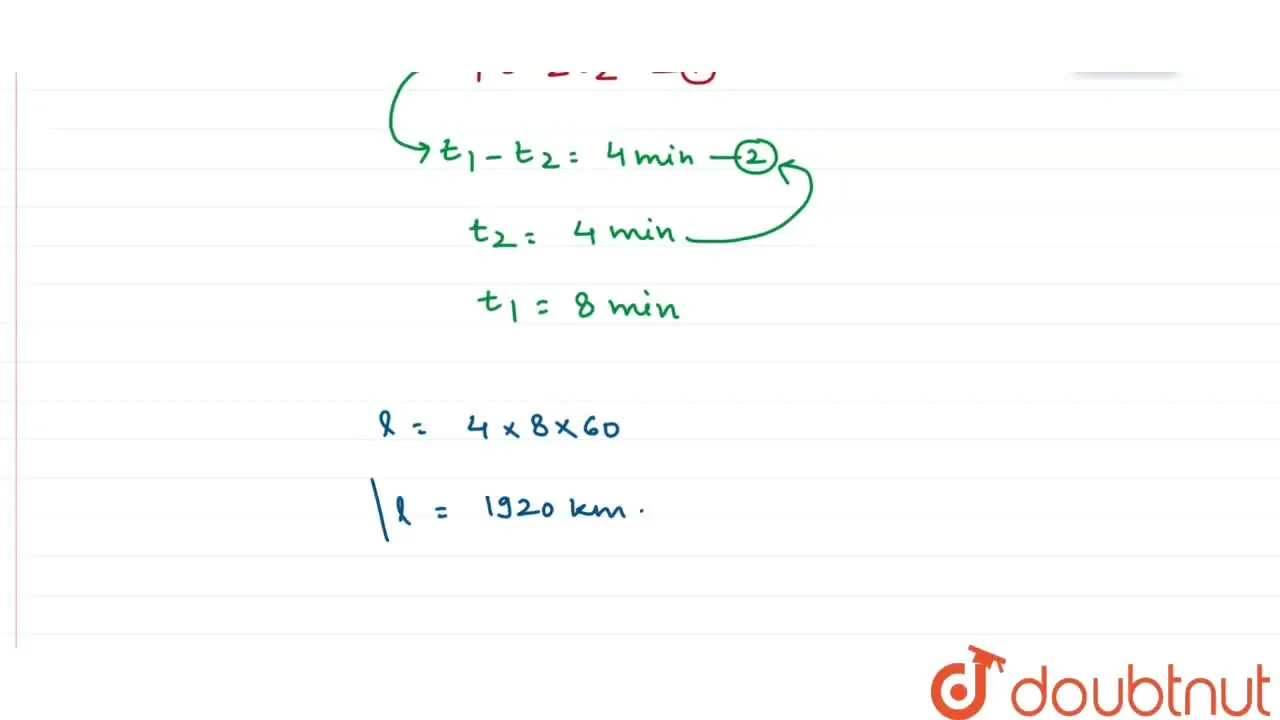Earthquakes generate sound waves inside the earth. Unlike a gas, the earth can experience both transverse (S) and longitudinal (P) sound waves. Typically, the speed of S wave is about 4.0 km s−1, and that of P wave is 8.0 kms−1. A seismograph records P and S waved from an earthquake. The first P wave arrives 4 min before the first S wave. Assuming the waves travel in straight line, how far away does the earthquake occur?
Let vSand vP be the velocities of S and P waves respectively.
Let L be the distance between the epicentre and the seismograph.
We have:
L=vStS(i)
L=vPtP(ii)
Where,
tSandtP are the respective times taken by the S and P waves to reach the seismograph from the
epicentre
It is given that:
vP=8km/s
vS=4km/s
From equations (i) and (ii), we have:
vStS=vPtP
4tS=8tP
tS=2tP(iii)
It is also given that:
tS–tP=4min=240s
2tP–tP=240
tP=240
And tS=2×240=480s
From equation (ii), we get:
L=8×240
= 1920 km
Hence, the earthquake occurs at a distance of 1920 km from the seismograph.
Related Playlists
Similar Questions
An earthquake generates both transverse (S) and longitudinal (P) sound waves in the earth. The speed of S waves is about 4.5 km /s and that of P waves is about 8.0 km/s . A seismograph records P and S waves from an earthquake. The first P wave arrives 4.0 min before the first S wave. The epicenter of the earthquake is located at a distance about
View SolutionAn earthquake generates both transverse (S) and longitudinal (P) sound waves in the earth. The speed of S waves is about 6 km s−1 and that of P waves is about 9 km s−1. A seismograph records P and S waves from an earthquarke. The first P wave arrives 5 minutes before the first S wave. the epicenter of the earth quake is located at a distance
View SolutionEarthquakes generate sound waves inside the earth. In case of the earth, both transverse (S) and longitudinal (P) waves can propagate. Typically, the speed of S waves is about 4.5 km s−1 and that of P waves is 8.0 km s−1. A seismograph records both P and S waves from an earthquake. this difference helps us to find the distanec of the point of origin of the earthquake. this point is called the epicenter.
Q. The reading of the time lag between the arrival of S and P waves gives us the distance of the epicenter from the location of a seismograph. the readings of what minimum number of seismographs would be necessary to pinpoint the location of an epicenter?View SolutionEarthquakes generate sound waves inside the earth. In case of the earth, both transverse (S) and longitudinal (P) waves can propagate. Typically, the speed of S waves is about 4.5 km s−1 and that of P waves is 8.0 km s−1. A seismograph records both P and S waves from an earthquake. this difference helps us to find the distanec of the point of origin of the earthquake. this point is called the epicenter.
Q. if at the location of a seismograph the P waevs arrive 2 minute earlier, the distance of the epicenter from the location of the seismograph isView SolutionEarthquakes generate sound waves inside the earth. In case of the earth, both transverse (S) and longitudinal (P) waves can propagate. Typically, the speed of S waves is about 4.5 km s−1 and that of P waves is 8.0 km s−1. A seismograph records both P and S waves from an earthquake. this difference helps us to find the distanec of the point of origin of the earthquake. this point is called the epicenter.
Q. If only 2 seismograph readings are available, how may probable locations of an epicentre could be detected?View SolutionSpeed of sound waves in air
View SolutionThe sound waves travel fastest:
View SolutionWhy is sound wave called a longitudinal wave ?
View SolutionA transverse wave is travelling on a string. The equation of the wave
View SolutionOcean waves of time period 10 s have wave velocity 15 ms−1. Find the wavelength of these waves .
View Solution


